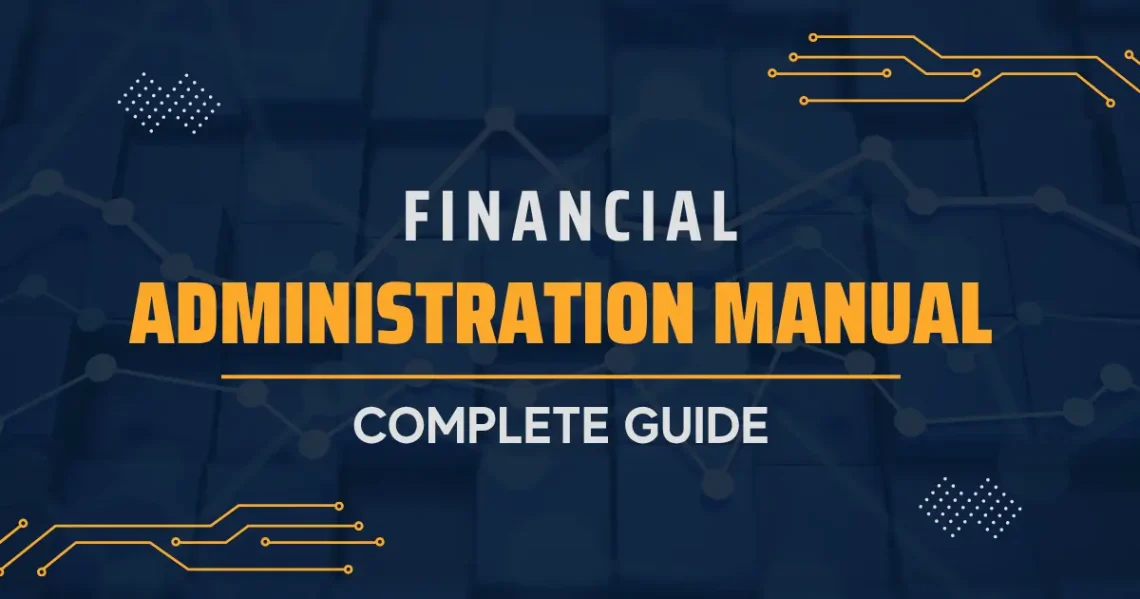Introduction to Financial Administration
Financial administration might sound like a fancy corporate term, but in reality, it’s something that touches almost every part of an organization—big or small. It’s all about planning, organizing, directing, and controlling the financial activities of an institution. Imagine it as the nervous system that makes sure money flows in the right direction, gets spent wisely, and is always accounted for.
Now, most people tend to think that financial administration is just about accounting or budgeting, but honestly, it’s way more comprehensive than that. It involves everything from managing assets and liabilities to ensuring compliance with laws and regulations. And let’s be honest—it’s not always straightforward. Mistakes can happen. Numbers get misreported, receipts go missing, or someone forgets to update a spreadsheet. That’s why having a clear and practical financial administration manual is like having a financial map—it helps you stay on track even when things get messy.
In this guide, we’re not going to bore you with jargon or complicated formulas. Instead, we’ll walk you through the concepts in a way that feels like a conversation over coffee. Whether you’re part of a nonprofit, a startup, or a school board, you’ll find insights here that can help you build a solid foundation for managing finances. Ready to dive in?
What is Financial Administration?
Financial administration is basically the behind-the-scenes work that keeps an organization financially healthy. It’s the process of managing money—how it’s earned, saved, invested, and spent. If we break it down, it involves several moving parts: planning budgets, monitoring expenditures, recording transactions, and analyzing financial data to make smart decisions.
Think of it like managing your personal budget, but with a few more zeros and a lot more responsibility. You don’t just pay bills—you also plan for future goals, emergencies, and improvements. Financial administration works the same way, but at a much larger scale and usually with more stakeholders involved.
One common misunderstanding is that it’s all about numbers, but that’s not true. Financial administration also involves people—communicating reports to staff, collaborating with departments, and ensuring that the financial plans align with the organization’s goals. If communication breaks down or someone doesn’t follow the process, things can spiral quickly. That’s why a structured approach, backed by a well-documented manual, is essential.
Even if you’re not a finance person, understanding the basics of financial administration can help you make better decisions. It makes the difference between operating in chaos and running things smoothly. And let’s face it, financial confusion is stressful. So the more we demystify it, the easier it becomes to handle—without the panic attacks every time you look at a spreadsheet.
Importance in Modern Organizations
In today’s fast-paced world, where every rupee or dollar counts, financial administration plays a crucial role. For businesses, it’s not just about tracking expenses or making profits—it’s about survival. Without proper financial oversight, organizations risk overspending, misallocating resources, or even facing legal issues.
Modern organizations operate in dynamic environments. Economic shifts, policy changes, and competitive pressures can hit unexpectedly. A strong financial administration system acts like a safety net. It ensures that there’s enough cash flow to keep things running, that audits don’t turn into disasters, and that stakeholders—whether they’re investors, board members, or donors—can trust the numbers they’re being shown.
Also, transparency and accountability have become non-negotiable. Whether it’s a corporate boardroom or a community nonprofit, people want to see where money is going. A financial administration manual helps enforce clear rules and routines, so nothing slips through the cracks. It creates a culture of responsibility.
Another thing worth mentioning is how tech has changed the game. With automation and digital tools, financial admin has become faster but also more complex. If your organization doesn’t have proper systems in place, it’s easy to get lost in data overload. That’s where a financial manual can step in—it simplifies procedures and keeps everyone on the same page.
In short, financial administration is no longer a “nice-to-have”—it’s a must. Whether you’re scaling a startup or managing a school’s funds, getting your financial ducks in a row can make or break your success.
Key Components of a Financial Administration Manual
A financial administration manual isn’t just a bunch of policies bound in a file collecting dust—it’s a practical tool that guides how an organization handles its money. Think of it like a GPS for your financial operations. When you’re lost or unsure, it tells you where to go and how to stay on track.
The manual breaks down the “what,” “how,” and “who” behind every financial task. What should be done (like submitting an invoice), how it should be done (such as steps for approval), and who is responsible (maybe the finance officer or project manager). This clarity keeps operations smooth and avoids those frustrating “I thought someone else was handling it” moments.
A well-rounded manual usually covers several core areas. First, there’s budget planning and allocation—you can’t spend what you don’t plan for. Then comes financial reporting and documentation—so your numbers tell a story everyone understands. Internal controls and audits are also crucial because they prevent errors and catch issues before they explode. And let’s not forget cash flow and asset management—because running out of cash is the fastest way to shut things down.
The beauty of a manual is that it evolves. As your organization grows or shifts direction, you can adapt the manual to fit your needs. It’s not meant to be a rigid set of rules but rather a living guide that reflects how your team operates and what keeps your finances stable and trustworthy.
Let’s dive into each component individually now.
Budget Planning and Allocation
Budgeting might not sound exciting at first glance, but it’s actually one of the most empowering tools in financial administration. When you plan your budget properly, you’re not just deciding how much money goes where—you’re giving your organization a roadmap for the future.
In simple terms, budget planning is the process of estimating income and outlining expected expenses for a given period. But it’s not just about the numbers. It’s about priorities. Where should funds be invested to create the most impact? What areas can survive with less? And what are the must-haves versus the nice-to-haves?
One of the most common mistakes in budget planning is guessing. Yeah, that might work in a casual home budget, but for an organization, it can be risky. You need data, past records, and realistic forecasting to create a solid plan. Then, once the budget is in place, comes the tough part: allocation. This is where departments start fighting (not literally… we hope) for their share of the pie. A good administrator uses logic, communication, and transparency to distribute funds fairly.
Also, flexibility matters. The best budgets aren’t set in stone. They allow for changes—like emergencies, new projects, or savings. The financial manual should explain how to request budget revisions and who approves them. Without these policies, changes become chaotic.
When done right, budget planning and allocation create a sense of direction and unity. Everyone knows what resources they have and what they can realistically achieve. And hey, who doesn’t feel more confident when the finances are clear?
Financial Reporting and Documentation
Let’s be real—paperwork isn’t anyone’s favorite part of the job. But when it comes to financial administration, documentation is non-negotiable. It’s how you prove that the money was used properly, and how you avoid those painful audits that feel like detective interrogations.
Financial reporting means regularly creating documents that explain how money has been spent and earned. These might include income statements, balance sheets, or cash flow reports. It’s not just for the finance department—it helps everyone, from the CEO to program staff, see where things stand.
Now, the documentation part may sound boring, but it’s actually the foundation of financial transparency. Receipts, invoices, payroll records, and contracts all need to be organized, filed, and backed up. Think of it like storytelling—with numbers. If your story doesn’t add up or there are missing pages, people start asking questions.
A financial manual should clearly explain how often reports are generated, who reviews them, and where everything is stored. It should also mention whether you use digital tools like QuickBooks, spreadsheets, or accounting software. The goal? Make it easy to find what you need when you need it—without digging through a pile of unmarked folders.
Consistency in reporting also builds trust. Stakeholders want to see that you’re not just spending wisely but also reporting honestly. Whether you’re answering to donors, investors, or a board of directors, good documentation speaks louder than promises.
So while reporting might seem tedious, it’s your proof of credibility. It’s what protects your organization when things go sideways—and let’s be honest, they sometimes do.
Internal Controls and Audits
Alright, let’s be honest—when someone mentions internal controls or audits, most people either tune out or start sweating. But they’re not meant to scare you. In fact, they exist to protect your organization. If financial systems were like a house, internal controls are the locks on your doors and audits are the safety inspections. They don’t stop the party—they make sure the house doesn’t burn down.
Internal controls refer to the policies and procedures that help prevent fraud, errors, and mismanagement. This might include things like requiring two signatures for large payments, separating duties so one person isn’t both writing and approving checks, or setting clear rules for how expenses are approved. These checks and balances aren’t about mistrust—they’re about reducing risk. Even good people make mistakes. Controls help catch them early.
Then there’s auditing. This can be internal (done by someone within your team) or external (hired professionals). The goal is simple: review financial practices and make sure they align with regulations and your own policies. Audits can feel stressful, especially if your documentation is disorganized or if you’re unsure what the auditors will find. But when you’ve got a solid manual and a clear control system in place, audits become more of a review than a headache.
Your manual should lay out how often audits occur, who conducts them, what they cover, and what happens when issues are found. It should also include protocols for correcting mistakes or reporting concerns.
Here’s the thing—no one ever regrets having strong internal controls. It’s not about being overly cautious. It’s about creating an environment where accountability is normal, and where mistakes don’t become disasters. Because when finances are on the line, you can’t afford surprises.
Cash Flow and Asset Management
Cash is king—it’s a cliché, but it’s also completely true. If your organization runs out of cash, nothing else matters. You might have grants pending, assets on the books, or big plans lined up, but without actual liquidity, operations grind to a halt. That’s why cash flow management is one of the most critical sections in any financial administration manual.
So, what exactly is cash flow? It’s the movement of money in and out of your organization. Sounds simple, right? But it’s not just about watching your bank account. You need to predict when funds will arrive and when payments are due. A delay in receivables, a surprise expense, or seasonal dips in revenue can all throw you off. That’s where cash flow planning comes in—it keeps you ahead of the curve instead of scrambling to catch up.
Now let’s talk asset management, which often gets overlooked. Assets aren’t just buildings or vehicles. They can be anything of value your organization owns—computers, tools, inventory, even intellectual property. Keeping track of these ensures nothing gets lost, stolen, or underused. A good manual will explain how to log, maintain, and evaluate assets. For example, it should include policies for depreciation, disposal, or insurance.
The financial manual should outline how to monitor daily balances, track recurring payments, and set up alerts for low reserves. It should also clarify who’s responsible for monitoring what—because when everyone assumes “someone else is watching it,” things fall apart.
Managing cash and assets is less about fancy calculations and more about vigilance. It’s like tending a garden. Ignore it for too long, and weeds (or financial problems) take over. Pay steady attention, and you’ll see sustainable growth.
Roles and Responsibilities in Financial Administration
Financial administration is a team effort. It’s not just one person sitting in a corner punching numbers into Excel—although that does happen too. It’s a whole system of roles, from the front desk to the boardroom, each playing a part in keeping the organization financially healthy. And honestly, when those roles aren’t clearly defined, that’s when confusion sets in, mistakes happen, and trust erodes.
One of the biggest benefits of a solid financial administration manual is that it spells out who does what. There’s no “I thought she handled that” or “Wait, that wasn’t my job?” Everyone from entry-level staff to department heads knows their responsibilities when it comes to handling money.
For example, maybe the admin assistant collects receipts, but the finance officer logs the expense. Maybe a manager approves a budget, but the accountant processes it. Clarity matters. These boundaries help prevent overlaps, missed tasks, and even fraud.
It’s also important to remember that financial management isn’t limited to the finance team. Department heads play a role by managing their own budgets. Executives are responsible for oversight. And boards or directors are accountable for final reviews and audits. Everyone has a part in the system—even if they’re not touching a calculator.
Another thing to consider is that responsibilities may evolve. As organizations grow, roles shift, and that’s okay—as long as the changes are reflected in the manual and communicated well.
A great financial administration manual not only tells people what to do but helps them feel empowered and secure in doing it. It creates a shared sense of responsibility and respect around money—something every healthy organization needs.
Duties of a Financial Administrator
If you’ve ever wondered what a financial administrator really does, here’s the truth: they’re the steady hand on the wheel. While the rest of the organization is chasing goals, launching programs, or managing day-to-day chaos, the financial administrator is making sure everything adds up—literally and figuratively.
Their core job is to handle the nuts and bolts of financial operations. That includes processing invoices, tracking budgets, managing payroll, maintaining ledgers, and preparing financial reports. They’re the ones ensuring the money comes in, goes where it’s supposed to, and is reported properly. Think of them as both gatekeeper and guide—ensuring that no financial action goes unchecked and that everyone follows the right processes.
But beyond the technical tasks, a great financial administrator is also a communicator. They don’t just crunch numbers in silence; they explain what those numbers mean to the people who need to know—like project managers or executives. Whether it’s warning about overspending or flagging a missing document, they need to speak up. And let’s be real, sometimes those conversations are awkward. But necessary.
In some organizations, the role expands to budget planning, grant tracking, or even tax compliance. In others, it’s more about managing systems and supporting finance teams. What matters most is that the responsibilities are clear in your financial manual. Vague expectations create gaps—and that’s when things fall through the cracks.
And yes, mistakes happen. Maybe a decimal was off, or a deadline was missed. It’s human. The goal isn’t perfection—it’s accountability and correction. A good manual helps the financial administrator know what’s expected, how to fix errors, and how to keep things transparent.
So while they may not always get the spotlight, financial administrators are often the quiet force keeping everything afloat.
Collaboration with Other Departments
You know that old saying, “Teamwork makes the dream work”? It couldn’t be more true in financial administration. A finance team—or even a solo financial administrator—can’t function in a silo. They need to collaborate with other departments constantly. Whether it’s marketing, operations, HR, or program teams, every department interacts with money in some way.
Let’s take a simple example. Say the marketing team wants to launch a new campaign. They’ll need a budget. Someone needs to approve that, track it, and later evaluate whether it paid off. That’s where the finance department comes in. Similarly, HR handles payroll and benefits—which must sync perfectly with the financial records. If there’s a miscommunication or delay, people’s paychecks might be wrong. And nobody wants that kind of heat.
A good financial administration manual should lay out how departments communicate, who they report to, and what the approval workflows look like. When is a manager allowed to make a purchase? Who submits reimbursement requests? Who signs off on new vendors? Answering these questions removes friction and builds trust.
Collaboration also builds transparency. When departments understand what finance needs from them (like timely receipts or budget justifications), they’re more likely to cooperate. And when finance understands the goals and pressures of other departments, they can give better advice—not just say “no” all the time. Let’s face it: nobody likes being told “it’s not in the budget” without context.
The key here is empathy and systems. Finance needs to speak in a language other departments understand, and other teams need to respect the rules that keep things running smoothly. It’s not about control—it’s about coordination.
When collaboration flows well, the whole organization runs better. Mistakes are caught early, goals align with budgets, and you waste less time fixing misunderstandings.
Conclusion
So, here we are—at the end of the financial trail, but honestly, it’s just the beginning. Creating and maintaining a Financial Administration Manual might not be glamorous, but it’s one of the smartest moves any organization can make. It’s more than just a binder of policies; it’s your financial playbook, your safety net, your go-to when things feel confusing or uncertain.
We’ve walked through the essentials—from budgeting and reporting to internal controls and cross-department collaboration. Every piece matters. Together, they create a system that helps you handle funds with confidence and accountability. And let’s not sugarcoat it—mistakes will happen. Invoices will go missing. Reports might be delayed. But when you’ve got a clear, practical manual in place, those mistakes won’t snowball into chaos.
More than that, a good manual brings people together. It sets expectations, clarifies roles, and encourages healthy communication across the board. And that’s important because financial administration isn’t a solo job. It’s a shared responsibility. When everyone knows what to do and how to do it, trust grows. Things run smoother. There’s less guesswork and more clarity.
If you’re just starting out, don’t stress over making it perfect. Start with the basics. Use plain language. Make it easy to follow. And most importantly, update it as your organization evolves. Think of your manual as a living document that grows with you—not a one-time chore to tick off a list.
Because at the end of the day, managing money wisely is about more than math—it’s about people, systems, and shared understanding. And a well-crafted financial administration manual? It’s the thread that ties it all together.
FAQs About Financial Administration Manuals
Q1: What exactly is a financial administration manual?
A financial administration manual is a document that outlines how an organization handles its money—step-by-step. It includes policies, procedures, and responsibilities related to budgeting, reporting, audits, asset management, and more. Think of it as the organization’s financial instruction book, designed to keep everything organized, legal, and running smoothly.
Q2: Who should create the financial administration manual?
Ideally, it should be a team effort. Finance professionals, senior leadership, and department heads should all contribute. While the finance department usually takes the lead, input from other teams ensures the manual reflects how things actually work in real life—not just how they’re “supposed” to.
Q3: How often should a financial administration manual be updated?
At least once a year is a good rule of thumb, or whenever there’s a major change—like new software, leadership, regulations, or financial goals. A manual isn’t meant to be static. It should evolve as your organization grows and adapts to new challenges.
Q4: Do small organizations really need a financial administration manual?
Absolutely. In fact, smaller teams often benefit the most. With limited staff and tighter resources, having a clear, easy-to-follow guide can prevent costly mistakes and reduce confusion. Even a simple manual can go a long way in building trust and consistency.
Q5: Can we use templates, or should we write the manual from scratch?
Templates can be a great starting point, but they shouldn’t be the final product. Every organization is different. Use a template as a structure, but customize it to reflect your team’s workflow, tools, and culture. That’s what makes the manual truly useful—and yours.






